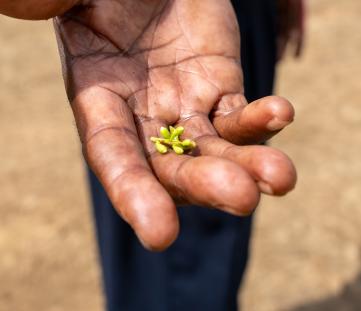ID: GRK-PLL
ID: GRK-PLL
Khanyu
Ficus semicordata
Photo
Nepal
06:58 - 23°C
My connections
My ID card
Who am I?
Date of birth
12/30/2021
Name
Khanyu
Tree
Khanyu
Where am I located?
Country
Nepal
Place of birth
Kalika
Coordinates
27° 59′ 27.88″ N
85° 13′ 30.5″ E
/85.22513984,27.99107877,0/500x333@2x?access_token=pk.eyJ1IjoidG9tbWFzb3NwZXJvbmkiLCJhIjoiY2tnOTE3eW12MDJqazMybXNzOWV1YjloOSJ9.wtGsuDU7XIKjcv2cq8CiXw&logo=false&attribution=false)
My Timeline
The important moments in your tree's life.
Seed
It all starts with a tiny seed, nice and warm in the soil.
Nursery
Your seedling is big enough to be welcomed into one of our nurseries, along with many others.
Planted
We’re here! Your tree has reached its new home: it’s been planted by a smallholder, who’ll take care of it for years to come.
Photo
Strike a pose! Now that it’s big enough, here’s a photo of your tree!
My Gallery
Nursery

Planted
/85.22513984,27.99107877,0/500x333@2x?access_token=pk.eyJ1IjoidG9tbWFzb3NwZXJvbmkiLCJhIjoiY2tnOTE3eW12MDJqazMybXNzOWV1YjloOSJ9.wtGsuDU7XIKjcv2cq8CiXw&logo=false&attribution=false)
85° 13′ 30.5″ E
Photo

Curiosity about me
The important moments in your tree's life.
Let's start with introductions
Khanyu is the Nepalese name of this species of Wild Fig tree, typical of this area. It can grow up to 10 meters in height and develops a very dense crown, which makes it an ideal tree to provide shade to other species. Its fruits are edible, rich in fiber and also have medicinal properties.
Meaning
Devotion
This tree is pollinated only by a species of wasp that lays its eggs inside its flowers. Their relationship is one of total and mutual devotion and symbiosis. For this reason the Khanyu flourishes several times over the seasons, so as to allow more opportunities for the wasp's reproduction.

How much CO2 I’ll absorb
My estimated CO2 absorption capacity is based on the first 10 years of my life*
Current absorption
- 30 kg
2021
0 kg
2031
-100 kg
* The tree will continue to absorb CO2 even after the tenth year. Therefore this is a prudent estimate.
How I am useful to local communities

Consumption and sales
Its fruits, seeds and/or leaves are used as food in the farmers' families or are sold on local markets.

Medicine
Its leaves, roots, bark and/or fruits are used in traditional medicine.
My benefits
80%
Food Security
The trees will bear fruits, some that will be edible immediately and others that can become edible through processing, ensuring food resources over time.
80%
Economic development
The trees' fruits and the products derived from their transformation can be traded in local networks, offering income opportunities.
50%
CO₂ Absorption
During its life cycle, each tree will offset CO₂. The trees that you plant can offset your emissions.
60%
Environmental protection
The trees are planted in agroforestry systems that favor the virtuous interaction between the different species and their positive impact on the environment and on the land.